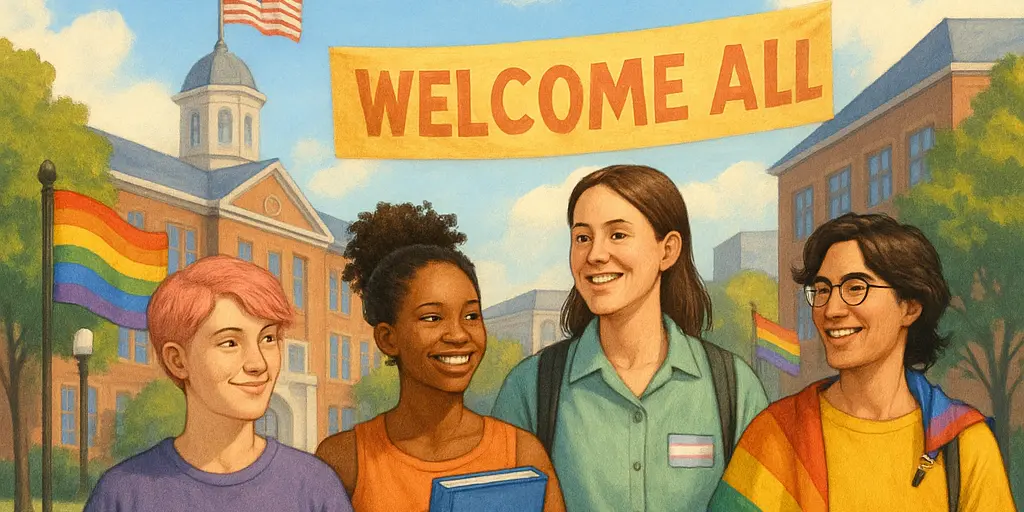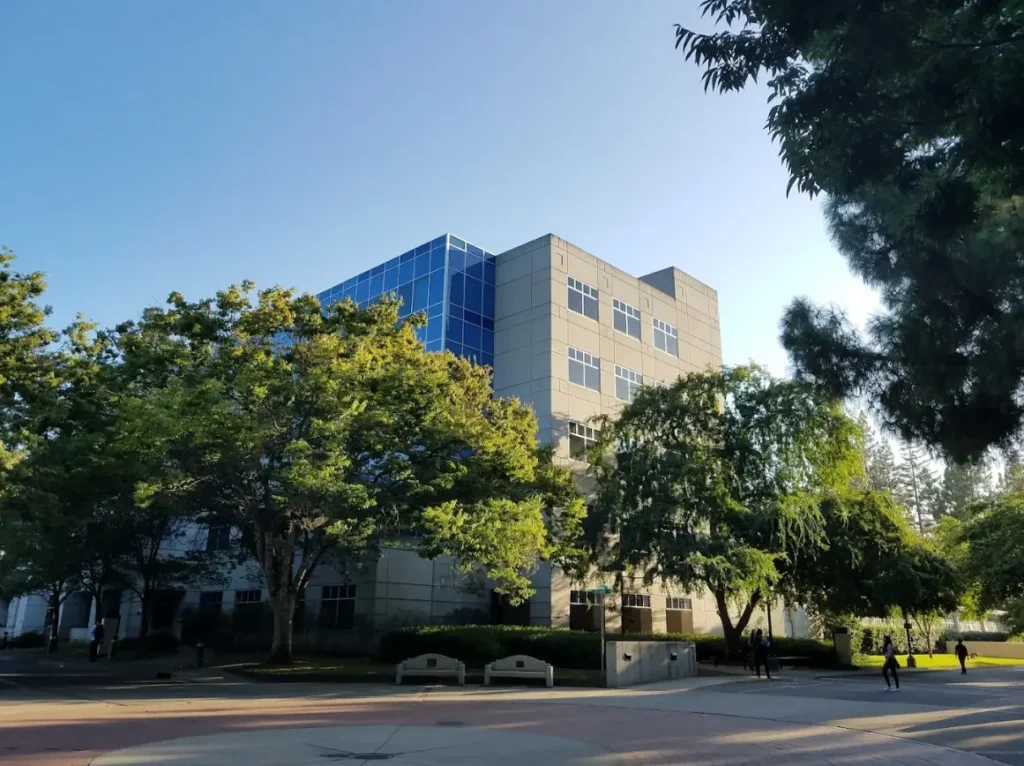The Best Trans-Friendly Colleges in the US for LGBTQ Students

Editor:
Olena Kosonogova
Author:
Olena Kosonogova
Olena Kosonogova (she/her), is PR Manager and a writer at Fiorry. Olena has a background as a psychologist and social work specialist, offering her a distinct viewpoint in her position. She effectively oversees public relations and produces insightful content. Based on her experience, she has a unique insight into human interaction and the significance of effective communication. When not busy with her profession, Olena loves her free time and balancing it out with tennis, taking her out and about, and a game of good chess that will challenge the mind.
Key Takeaways
- What a College Needs to Be LGBTQ-Friendly
- Legal & Policy Landscape (Brief Overview)
- How to Evaluate Trans-Friendly Colleges
- The Best and Most Friendly Colleges for Transgender Students
- Colleges with the Most LGBTQ Students
- Challenges & Progress Still Needed
- Practical Guide: Choosing the Right College for Trans & Queer Students
- Conclusion
- FAQ
Finding truly trans-friendly colleges in the US has become more than a matter of preference — it’s about safety, dignity, and the chance to thrive in an inclusive environment. Across the country, universities are finally moving beyond token gestures toward real inclusion, creating campuses where queer and trans students can live and learn without fear of judgment. These changes show that higher education is evolving — from gender-neutral dorms and all-gender restrooms to professors who respect pronouns and healthcare plans that cover transition-related care.
Nevertheless, the selection of the appropriate school does count. Campus cultures differ: what feels like a supportive environment in California might feel isolating in another state. That’s why understanding a college’s campus climate and policies before applying is essential for every member of the LGBTQ students’ community.
In case you want a fitting place to call home, either school or socially, then start with forming ties at a young age. Use a trans dating application focused on trans people such as Fiorry, where students of both transgender and cisgender identity can share and gather, experience, and help each other in the path of learning and discovering their identity. It is not just a date but rather a quest to get new friends who know you well and this is how a truly inclusive college life is built on.
What a College Needs to Be LGBTQ-Friendly
A truly welcoming campus goes far beyond rainbow flags during Pride Month — it’s about daily structures that protect and uplift trans students. The most gender inclusive colleges in the U.S. design their systems to recognize everyone’s gender identity as valid and respected. That begins with inclusive policies: allowing students to use chosen names and pronouns on class rosters, diplomas, and housing forms without red tape.
Physical space matters too. Gender inclusive housing means students can live with peers who affirm who they are, not according to outdated binary rules. The same applies to gender inclusive bathrooms, which may seem simple but make a profound difference in comfort and safety. These facilities convey the message to students that they belong to the institution.
Equally vital are gender-affirming healthcare options and counseling services. When universities have systems in place to cover their cost for hormone therapy or transition-related care, the message they send is that well-being is part of an education. Combined with visible student groups and staff training, these elements build a genuine safe space where no one has to hide.
In short, trans-friendly colleges have inclusion written large — or, rather, on all the policies, classrooms, and dorms.
Legal & Policy Landscape (Brief Overview)
Behind every truly welcoming campus stand LGBTQ-friendly policies that align with — or go beyond — federal protections. Title IX provides against gender identity and sexual orientation in education. This legal foundation ensures transgender students have the same right to learn and live safely as anyone else. But interpretation and enforcement differs broadly across states, with the picture being skewed nationally.
Some universities strengthen their inclusive policies through dedicated student affairs offices that monitor equity and support marginalized communities. Others modernize administrative systems, so students can update their name and gender markers without invasive procedures. Schools in states like California, New York, and Massachusetts have pioneered LGBTQ-inclusive policies, ensuring medical coverage for gender-affirming care and explicit anti-discrimination language in campus codes.
On the other hand, college seekers who query trans near me colleges close by states with fewer protections might find it difficult, however, in even those states, campuses can adopt a unilateral policy to promote safety and inclusion. The most progressive organizations do not consider equality as a command, but as an obligation to all members of the society.
How to Evaluate Trans-Friendly Colleges
Knowing where to apply starts with understanding how to judge a school’s real commitment to inclusion. The Campus Pride Index is a great starting point — a national benchmarking tool that ranks universities by their policies, programs, and climate for LGBTQ+ people. Schools scoring 4.5 or higher usually maintain active student organizations, comprehensive support groups, and gender-affirming practices built into campus culture.
Look for visible resource centers and peer mentoring networks — these serve as lifelines for both new and current students. A robust community of members who participate in open dialogues and events shows that diversity isn’t confined to policy statements. Equally telling are facilities like a gender-affirming closet or spaces offering free gender-affirming clothing to students who need it.
When researching, don’t stop at glossy brochures. Talk directly with student groups, browse campus social channels, and check annual climate surveys. The best colleges treat inclusion as everyday practice — not just celebration during Pride Month. For prospective students seeking genuine acceptance, these markers reveal where respect, support, and belonging truly live.
The Best and Most Friendly Colleges for Transgender Students
Across the country, a growing number of universities have earned reputations as safe, empowering, and LGBTQ-friendly spaces for transgender students. These institutions prove that academic excellence and inclusion can thrive together, offering more than classrooms — they provide a supportive environment where queer and trans people are recognized, respected, and celebrated. From gender inclusive housing to comprehensive healthcare and counseling, these campuses lead the way in modern higher education. Each college below stands out for its inclusive culture, community outreach, and forward-thinking degree programs that embrace diversity as a strength, not a slogan.
University of Massachusetts Amherst
300 Massachusetts Ave, Amherst, MA 01003, USA
Among the most recognized LGBTQ-friendly colleges in the nation, the University of Massachusetts Amherst has built a lasting model for inclusion and academic excellence. Its on-campus Stonewall Center—founded in 1985—is one of the oldest university support centers for LGBTQ+ people in the United States, offering peer mentoring, workshops, and ally training for students and staff alike. The university provides gender-inclusive housing options, health coverage for transition-related care, and a visible commitment to equality woven through every aspect of student life.

In national education statistics, UMass Amherst consistently ranks high for both academic quality and diversity, proving that excellence and empathy can coexist. Its vibrant community hosts pride events, inclusive lectures, and advocacy projects throughout the year, reinforcing why it remains one of the most LGBTQ-friendly campuses in Massachusetts Amherst and beyond. Compared to restrictive climates in states like Florida, where many Orlando trans students still face barriers, UMass stands as a beacon of progress.
Rutgers University
Rutgers University has long stood as one of the most LGBTQ-friendly public institutions in the United States. Its Center for Social Justice Education & LGBT Communities promotes equality through mentorship, peer education, and advocacy, ensuring that every student finds belonging. The university offers gender inclusive housing and restrooms across all campuses, along with mentorship programs designed to support both undergraduate and graduate queer students.

Consistently praised by Campus Pride for its commitment to inclusion, Rutgers integrates awareness training into student leadership and housing staff programs, embedding respect into daily life. With a diverse student population, it represents how large universities can still maintain a strong sense of safety and community through proactive inclusive housing and policy enforcement.
While other regions, such as Nevada, still strive to expand rights for Las Vegas trans residents, Rutgers serves as a reminder that bold institutional support can create campuses where authenticity and ambition flourish side by side.
Ithaca College
953 Danby Rd, Ithaca, NY 14850, USA
Ithaca College is one of New York’s most welcoming campuses for queer students, offering a strong network of programs that celebrate diversity and identity. Its Center for LGBT Education, Outreach & Services anchors a vibrant community where queer and trans students find mentorship, resources, and advocacy throughout their college years. The center also hosts regular workshops and support meetings that help trans people feel seen, valued, and protected in every part of campus life.

From gender-affirming housing options to inclusive counseling services, Ithaca ensures that well-being and authenticity remain top priorities. Academic inclusion runs deep too — its renowned gender studies program gives students tools to understand gender, culture, and social justice through a modern lens.
Much like inclusive networks in big cities such as Chicago, where trans dating Chicago communities foster connection and pride, Ithaca demonstrates that smaller colleges can create equally powerful spaces for queer students to thrive.
Reed College
3203 SE Woodstock Blvd, Portland, OR 97202, USA
Renowned for progressive values and academic independence, Reed College in Portland stands out as a leader in LGBT education and student-centered inclusion. The campus provides fully gender inclusive bathrooms, accessible across all buildings, and a visible network of peer-led support groups that center the voices of queer and trans people. These programs foster daily authenticity rather than seasonal visibility, ensuring every student feels acknowledged and respected.

Reed also supports nonbinary students through policy and culture, offering flexible housing and administrative systems that accommodate chosen names and pronouns. Its gender-affirming closet supplies clothing and resources to anyone exploring identity expression, while regular community workshops encourage empathy and understanding among queer students and allies.
In contrast to more challenging regions, such as Florida — where many trans in Miami individuals still advocate for safe spaces — Reed demonstrates how equity and education can thrive together when inclusion is woven into the institution’s DNA.
University of California
1 Shields Ave, Davis, CA 95616, USA
At the forefront of inclusion in California, the University of California – Davis sets a national example for trans-affirming education. Its campus features extensive gender inclusive housing options, all-gender restrooms, and a dedicated Q Center offering peer support, counseling, and community events. The university’s programs for trans students include access to specialized healthcare, advocacy workshops, and mentorship pairing through the LGBTQIA Resource Center.

UC Davis also fosters a strong alliance between LGBTQ students and allies, ensuring an inclusive environment that encourages authenticity both inside and outside the classroom. Students can engage in leadership development and mentorship opportunities designed to strengthen representation and inclusion across all academic fields.
While regions like Texas are still evolving in their protections for trans dating Houston communities, UC Davis shows how consistent institutional commitment can create a truly safe and empowering place for every student to thrive.
The New School
66 W 12th St, New York, NY 10011, USA
Few urban campuses embody inclusivity like The New School in New York City. Known as one of the most LGBTQ-friendly universities in the country, it combines creative academics with robust student advocacy. Its gender inclusive housing policy lets students choose living arrangements that match their identity, while the LGBTQ+ Center offers resources, events, and wellness guidance for queer students and allies alike.

From pronoun recognition in digital systems to fully inclusive housing and gender-affirming healthcare, the university ensures that every student feels safe and seen. Dedicated mentorship programs connect newcomers with experienced community members, promoting connection and resilience.
For trans students, New York’s progressive climate amplifies The New School’s welcoming spirit. The city’s diversity — mirrored by inclusive spaces and active trans dating NYC communities — helps turn campus inclusion into a living, breathing culture of acceptance.
Sacramento State University
6000 Jed Smith Dr, Sacramento, CA 95819, USA
At Sacramento State, the PRIDE Center anchors a welcoming hub for queer and trans students, offering advocacy, peer mentoring, and workshops focused on well-being and identity development. As one of the more forward-thinking college campuses in the region, Sac State integrates inclusion into everyday life: gender inclusive restrooms across facilities, chosen-name practices in class systems, and active training for staff and faculty.

Housing matters, too. The university’s campus housing team collaborates with the PRIDE Center to support room placements that respect students’ identities and safety needs, while community dialogues and student-led events connect community members across majors and backgrounds. Beyond services, the campus culture emphasizes visibility—regular programs during LGBTQ+ History Month, trans awareness events, and resource navigation for healthcare referrals.
For readers searching around Northern California—think TS Sacramento communities—Sac State shows how pragmatic policy and everyday compassion can make a public university feel like home.
Colleges with the Most LGBTQ Students
Some U.S. campuses stand out not just for their academics, but for having the highest LGBT populations and the most visible, active communities of college students. These are often large public universities and inclusive private schools in progressive cities, where equality is part of daily life. Schools with the most LGBTQ students combine inclusive policies with real cultural support.
What makes these institutions the best and top examples isn’t only their diversity numbers, but how they turn inclusion into practice. They offer gender-affirming healthcare, strong resource centers, and degree programs that integrate social equity into the curriculum. Professors, advisors, and housing teams receive regular training to better support queer and trans students.
These universities also lead in social justice initiatives, scholarships, and mentorship programs that strengthen representation in leadership and research. When exploring colleges, look for visible LGBTQ offices, peer networks, and transparent policies. Schools with the most welcoming environments prove that true inclusion isn’t measured by slogans—it’s reflected in how every student is seen, respected, and encouraged to succeed.
Challenges & Progress Still Needed
Even the most friendly colleges face ongoing challenges when it comes to equality for trans people. While many campuses now provide inclusive housing and name-change options, gaps remain in mental health access, staff training, and awareness. Some states continue to introduce restrictive laws that directly impact trans students and LGBTQ-youth, forcing universities to balance compliance with compassion.
National organizations like the National Center for Transgender Equality help schools navigate these obstacles, but progress still depends heavily on leadership and student advocacy. Real inclusion means more than avoiding discrimination — it’s about creating systems that actively protect identity, safety, and growth.
Across the country, student-led efforts and faculty allies continue to push higher education toward true equity. The path is far from complete, but each policy revision, new gender-neutral dorm, and visible trans scholar marks another step toward genuine social progress and social justice.

True inclusion means building systems that never ask anyone to hide who they are
Practical Guide: Choosing the Right College for Trans & Queer Students
Finding the right college means looking beyond rankings and checking how campuses actually support queer and trans students. Talk to current students to learn what daily life feels like—housing, safety, and campus culture often matter as much as academics.
For queer international students, it’s especially important to confirm available visa and healthcare support. Review policies on name changes, access to gender-neutral housing, and whether there are year-round mentorship programs or an LGBTQ+ center hosting LGBTQ History Month events. Also consider college affordability, since inclusive financial aid can determine whether a supportive campus is truly accessible.
When connecting socially, remember that online spaces can help you meet future classmates safely. Apps like Fiorry—a welcoming and verified trans dating app—make it easier to connect before you move. Use it thoughtfully, just as you would when learning how to find trans women on Tinder, and focus on building real, safe friendships first.
Conclusion
The journey toward truly inclusive higher education continues, but every year brings new proof that progress is real. The best colleges no longer see diversity as an afterthought — they design systems where LGBTQ students and trans students can live authentically, learn freely, and build lasting connections. An inclusive environment is more than policy; it’s an everyday practice of respect, equality, and empathy woven into classrooms, dorms, and student life.
A genuinely supportive environment allows students to focus on their ambitions instead of barriers, shaping a generation that values openness and care. The colleges featured in this guide are leading that change, reminding us that education works best when everyone belongs.
If you’re ready to take the next step — academically, socially, or personally — join Fiorry, a trusted national community for trans and cis allies. It’s more than an app; it’s a bridge connecting students across inclusive campuses nationwide.
FAQ
What defines a trans-friendly college?
A college with gender-inclusive housing and bathrooms, name/pronoun recognition, healthcare for transition-related needs, and visible LGBTQ+ support systems.
Which states have the most inclusive campuses?
California, New York, Oregon, and Massachusetts consistently host universities rated highest on the Campus Pride Index for LGBTQ+ inclusion.
How can I verify if a college supports trans students?
Check the Campus Pride Index, review the school’s nondiscrimination policy, and contact its LGBTQ+ or diversity office for current initiatives.
Do trans students have access to healthcare on campus?
Many universities now provide gender-affirming care through student health plans or local partnerships, especially at major public research institutions.
How can I connect with LGBTQ+ peers before college?
Join verified online communities like Fiorry, where students meet, exchange advice, and form friendships before stepping onto campus.
Time to read: 15 min.






South Korean politician and diplomat
Ban Ki-moon
Inclusive education is not a privilege. It is a fundamental human right